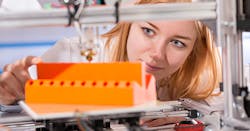The Environmental Protection Agency (EPA) is increasing its scrutiny of 3D printing emissions just as recent predictions say the technology is just beginning to revolutionize manufacturing and the supply chain.
Working in cooperation with the Consumer Products Safety Commission (CPSC), EPA is studying possible harmful emissions that are emitted during the 3D printing process. Also conducting research on 3D printer nanomaterials is the National Institute of Standards and Technology (NIST).
“Users may not be aware of chemical emissions during the printing process,” notes Dr. Souhail Al-Abed, who is the lead scientist on the new EPA study. So far, his team’s research shows that common 3D printer ink, called filament, can emit gases during the printing phase that may pose a health risk to users and bystanders, EPA reports.
The most concerning of these are emissions known as volatile organic compounds (VOCs). Although there already have been many studies on the effects of VOCs produced by 3D printing, none of the research considered how these emissions change when certain additives are introduced to the 3D printing filament.
Dr. Al-Abed’s team closely examined a commonly available filament that is sold both with and without carbon nanotube inclusions to determine whether VOC emissions changed between the two types of product. EPA’s research focused on the potential effects of adding carbon nanotubes (CNTs) to filament composed of acrylonitrile-butadiene-sytrene (ABS)—a common polymer used in 3D printing.
The agency’s researchers were particularly interested in CNTs because they are increasingly being added to filaments to create electrical components because of their conductive and thermal properties.
Using a device called the System for Thermal Diagnostic Studies (STDS), EPA tested two filaments—one composed solely of ABS and one that contained CNTs—under a variety of conditions to simulate the heating, melting and forming of plastics that occur during 3D printing. The filament samples were tested at different temperatures, for different lengths of time and with different oxygen concentrations to replicate common printing conditions.
EPA’s study conclusions were:
• The ABS-CNT filament resulted in the emission of two additional VOC—2,4-di-tert-butylphenol and 2,6-di-tert-butylquinone—which were not emitted by the ABS filament and which could pose an inhalation hazard to users printing several kilograms of material.
• The presence of CNTs in filament lowered the total VOC emissions under most conditions, but they increased the amount of emissions from the most hazardous VOCs, including a-methylstyrene and benzaldehyde.
• Higher print temperatures had the most significant effect on increasing VOC emissions, followed by increased length of time heating the materials.
• CNTs may “trap” certain VOC gases in the resulting printed plastic items.
THE COMING DISRUPTION
“This study, as well as EPA’s continued focus on emissions released from 3D printing, may have a dramatic effect on the evolution of this technology,” predict attorneys Alexander Woo and Lauren A. Bachtel of the law firm of Hunton Andrews Kurth. “This is likely the beginning of a much deeper dive for EPA into the 3D printing space.”
Although the printers are becoming increasingly popular with consumers for use in the home, their biggest impact has been found in industrial uses in additive manufacturing, where their use also can eliminate portions of the supply chain needed for creating new parts.
The global additive manufacturing market grew to more than $10.4 billion in 2019 and recent forecasts say this market will grow to $55 billion by 2029, according to a market report issued by SmarTech Analysis.
Last year Mazars, an accounting and management consulting firm, reported that 4% of airplane parts currently are made using 3D printing, and predicted that in another decade 40% of them will be manufactured this way, and 10 years after that only a handful of those parts will not originate from additive printing.
“3D printing is no longer a novelty, as manufacturers in the automotive, aviation, medical, consumer goods, entertainment and numerous other industries are integrating 3D printing into their production processes,” observe Woo and Bachtel.
The computer giant HP argues that the growth of 3D printing actually will end up being good for the environment. “Traditional manufacturing processes were designed with little thought to the environment,” the company points out in a recent forecast. “As industrial 3D production intersects with manufacturing for example, the impact on the planet could be immense as nearly one-third of carbon emissions are related to the production and distribution of goods.”
HP says that 3D printing will enable the manufacturing industry to produce less waste, less inventory and less CO2 emissions. In addition, it allows engineers and designers to rethink design throughout the product lifecycle in order to use less material and reduce waste by combining parts and using complex geometries to produce lightweight parts.
This further reduces the weight of vehicles and aircraft to improve fuel efficiency, which can reduce greenhouse gas emissions and energy consumption, HP says, pointing out that as more manufacturers transmit digital files for production locally rather than shipping goods, there will be significant decreases in shipping, which reduces costs, energy consumption, waste and emissions.
CREATING OPPORTUNITIES
The technology also is positioned to support development of more environmentally-friendly transportation technology, HP stresses. According to its forecast, the large volumes of parts the automotive industry produces annually, combined with the fast prototyping and production capabilities of 3D printing, will enable automakers and manufacturers to make car parts that were previously impossible to create, pushing the capabilities of electric and even autonomous vehicles to new levels.
“The year ahead will be a time of realizing 3D printing and digital manufacturing’s true potential across industries,” says Pete Basiliere, founder of Monadnock Insights, which helped HP with its research. “As HP’s trend report indicates, digital manufacturing will enable production of users’ ideal designs by unlocking new and expanded software, data, services and industrial production solutions that deliver more transformative experiences while also disrupting legacy industries.”
HP also agrees about the potential for 3D printing to drive new supply chain efficiencies. “The capability to deliver things digitally and produce things locally has not always won out. At the end of the day, manufacturers must analyze where in the supply chain it’s the most efficient to root production—whether that’s near the end users or near the source of material production.”
HP predicts that the technology will help fuel the arrival of automated assembly, with industries seamlessly integrating multi-part assemblies including combinations of both 3D printed metal and plastic parts.
“There’s not currently a super printer that can do all things intrinsically, like printing metal and plastic parts, due to factors such as processing temperatures,” HP admits. “However, as automation increases, there’s a vision from the industry for a more automated assembly setup where there is access to part production across both metals and plastics simultaneously.”
This could benefit the auto industry by enabling manufacturers to print metals into plastic parts, build parts that are wear-resistant and collect electricity, add surface treatments and even build conductors or motors into plastic parts.
Footwear, eyewear and orthodontics are products where 3D printing applications are seeing rapid adoptions, HP reports, adding, “there’s a massive application space around footwear that’s very lucrative for the 3D printing industry.”
According to SmartTech, footwear 3D printing is set to grow into a $6.3 billion overall revenue opportunity over the next 10 years. “Orthodontics and eyewear fit alongside this growth opportunity as well, given there’s a lot of value for the customization capabilities that 3D printing brings,” HP says. “Case in point -- disrupter SmileDirectClub is digitally transforming the $12 billion orthodontics industry.”
As a result, if concerns over emissions concerns can be allayed by adopting new processes and materials, 3D printing is on the verge of revolutionizing manufacturing and supply chains, not just in some hazy, far-off future, but over the next few years.
About the Author

David Sparkman
founding editor
David Sparkman is founding editor of ACWI Advance (www.acwi.org), the newsletter of the American Chain of Warehouses Inc. He also heads David Sparkman Consulting, a Washington D.C. area public relations and communications firm. Prior to these he was director of industry relations for the International Warehouse Logistics Association. Sparkman has also been a freelance writer, specializing in logistics and freight transportation. He has served as vice president of communications for the American Moving and Storage Association, director of communications for the National Private Truck Council, and for two decades with American Trucking Associations on its weekly newspaper, Transport Topics.
